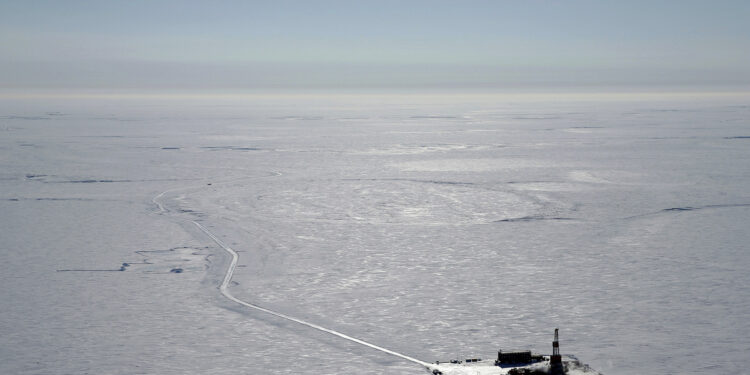President Donald Trump made sweeping changes to U.S. oil and gas policies in Alaska on his first day back in office.
Now, the state’s leaders want to make sure the new approach sticks.
Trump’s move opens up wide swaths of the Arctic to potential drilling, and it could pave the way for a long-delayed liquefied natural gas project and pipeline system to move ahead. Alaska Gov. Mike Dunleavy (R) is among those hoping that new policies can be enshrined in federal law so they can remain in force no matter who is in the White House.
“You have investors that’ll look at places all over the world — they’ll go into risky places in sub-Sahara Africa or Central Africa and invest,” Dunleavy said in an interview. “But they would basically tell me, ‘Look, yeah, you’re part of America, but it’s so unpredictable in Alaska that with each and every four years there’s a risk of a whole new set of rules.’”
While congressional action to open up more Alaskan energy may not be easy to achieve, Dunleavy said he believes a Republican-controlled Congress and Senate may be able to team up with Trump to pass more legislation to pave the way for increased oil and gas production in Alaska.
For decades, Alaska has been a battleground between conservationists and the energy industry over whether and how oil and gas production should happen in one of America’s most untouched landscapes. Federal policy has shifted between presidential administrations and Congresses about how much federal land in Alaska can be opened to drilling, whether and where pipelines can be built and what standards the energy industry should meet in production.
Trump has undone a series of Biden-era executive orders in federal lands around the state. Biden signed an executive order in 2021 halting all oil and gas activity in the Arctic National Wildlife Refuge (ANWR) and did not hold new lease sales in the National Petroleum Reserve-Alaska, among other actions.
Those decisions are moot under Trump’s “Unleashing Alaska’s Extraordinary Resource Potential” executive order. Trump’s order calls for expediting permitting and leasing for oil and gas production on Alaska’s North Slope, which is home to both ANWR and the NPR-A. It will reinstate a management plan of the NPR-A that opened about 80 percent of the 23-million-acre reserve to oil and gas leasing during the first Trump administration.
Trump’s executive order and Dunleavy’s hopes to prolong its impact come as Alaskan oil and gas production has experienced a “renaissance” in the last 10 years, said Mark Oberstoetter, head of Americas upstream research outside the Lower 48 at the Wood Mackenzie consulting firm.
“Really what’s changed is they’ve made a geological discovery both on state administrative land and in the [NPR-A],” Oberstoetter said. “They’ve found some new oil and companies think it makes economic sense to develop some of these large discoveries.”
Two new massive oil projects underscore those new finds: ConocoPhillips’ Willow project and Australian company Santos’ Pikka project, both located in the northern part of Alaska.
Both projects are scheduled to start producing in 2026 under Trump’s watch, although he did give approval for the projects. The Pikka project was approved by the Alaska Department of Natural Resources, while Willow was approved by the Biden administration. At the same time it approved Willow, the Biden administration took steps to protect much of the Arctic from further oil and gas drilling.
Trump also rescinded an eleventh-hour Biden order that placed an oil leasing moratorium on more of the northern Bering Sea off Alaska and wide swaths of the Pacific and Atlantic Coasts, although it’s unclear whether Trump’s reversal will stand up in court.
However, those projects and Trump’s new executive order have generated fierce pushback from environmental groups and conservationists that say oil production in the Arctic could irreparably harm an ecologically fragile area and worsen the impacts of climate change.
Kristen Miller, executive director of the Alaska Wilderness League, pointed to vehicle tracks made by seismic exploration in the 1980s that are still visible just south of the ANWR boundary.
“It shows how fragile the ecosystem is,” Miller said. “Caribou are incredibly sensitive, and it’s changing their migration routes. It really is an ecosystem, a web of life, where all of these pieces fit together and rely on each other.”
Lease sales
The past nine years have seen oil and gas policy in Alaska zigzag, with Trump in his first term opening up much of the state’s federal lands for fossil fuel development and Biden undoing most of those actions in favor of more environmental restrictions.
In 2017, Congress passed a rewrite to the tax code that included a provision opening up ANWR for oil and gas leasing, and the Trump administration held a lease sale for the area in 2021.
That sale ended up flopping.
The state of Alaska ultimately won nine of the 11 tracts available in its bid to support the sale, and the remaining two tracts were won by smaller companies. The sale yielded $14.4 million for the right to explore for oil across about 600,000 acres.
While Biden did not hold any lease auctions in ANWR or the NPR-A, Oberstoetter said companies may start looking anew at the area after the Biden administration greenlit the Willow project and now that Trump has issued his executive order.
“There might be companies looking to drill and refill the project coffers,” Oberstoetter said. “Specifically, we’ve seen more activity in the NPR-A and not as much in ANWR. The geology is more proven in the NPR-A, but also companies may not have the appetite for court challenges in ANWR.”
Fifteen states in 2020 sued to try to block the Trump administration’s ANWR lease sale, as did multiple environmental groups and at least one Alaskan tribe. While those legal challenges failed, Miller with the Wilderness League said economics may make Alaskan oil and gas projects difficult to complete.
She cited the high cost associated with building roads on permafrost, shipping equipment to Alaska and the technical challenges associated with drilling in the Arctic.
“From economic perspective, oil companies aren’t interested,” Miller said. “They’re not going to make enough revenue to justify the cost.”
Attempts to reach the Alaska Oil & Gas Association were unsuccessful. But Kara Moriarty, the association’s CEO, released a statement last April that was critical of a Bureau of Land Management decision during the Biden administration to place new regulations on oil and gas development within the NPR-A.
“These changes guarantee even more legal and procedural hurdles, aiming to scare off investors and developers, at a time when the world demands more oil from stable countries,” Moriarty said in the statement.
‘Not California’
Alaska Gov. Mike Dunleavy (R) holds a news conference Dec. 12, 2024, in Juneau, Alaska, outlining his budget proposal for the coming year. | Becky Bohrer/AP
Since Trump’s executive order on Alaska, Dunleavy said he has spoken to industry officials who have expressed interest in producing Alaskan oil and gas.
One major project he said is pushing ahead is the long-delayed Alaska LNG project. The $44 billion project, which includes a 807-mile pipeline that would bring natural gas from Alaska’s North Slope to an export facility in South Central Alaska, has faced legal challenges and has struggled to secure funding.
In January, the state’s Alaska Gasline Development Corp. said it was partnering with the Glenfarne Group to move the project forward. Trump’s executive order also prioritized the permitting of all pipeline and export infrastructure for the Alaska LNG project.
“It telegraphed to the world where the president stands” on the Alaska LNG project, Dunleavy said.
That telegraph landed in Japan. Earlier this month, Trump said that Japan will soon import “historic new shipments” of U.S. LNG through Alaska, which he said is “by far” the closest point of major oil and gas supplies to Japan.
“We’re talking about a joint venture of some type between Japan and us having to do with Alaska oil and gas, and it’s very exciting,” Trump said during a press conference with Japanese Prime Minister Shigeru Ishiba on Feb. 7.
Japan’s Foreign Ministry said in a statement that the meeting between Trump and Ishiba was beneficial to both countries and confirmed that the two countries would cooperate on energy projects, “including increasing LNG exports to Japan,” according to the Associated Press. The Japanese Ministry did not specifically mention the Alaska LNG project.
Dunleavy told POLITICO’s E&E News he believes Trump could issue more executive orders, including some that could impact mineral or oil and gas production in Alaska.
“I view what’s happening now in the Trump administration as the first tranche of executive orders,” he said. “And then the discussions really need to happen this spring to see what Congress can do before it’s too late, because four years goes by fast. That’s the problem.”
Alaska’s congressional delegation has been supportive of opening up the state to more oil and gas production.
Amanda Coyne, a spokesperson for Sen. Dan Sullivan (R), wrote in a statement that the senator is “working closely with the Trump administration, the State of Alaska, and his colleagues to implement the Alaska-specific executive order.” Sen. Lisa Murkowski did not respond to a request for comment.
But Murkowski and Sullivan and Alaska Rep. Nick Begich, who is also a Republican, released a joint news release on Jan. 21 with Dunleavy praising the order and highlighting its plan to takes steps to “end the assault on Alaska’s sovereignty and its ability to responsibly develop [its] resources for the benefit of the Nation.”
In a separate statement to E&E News, Begich said Trump’s executive order will help open up Alaska to more oil and gas jobs and production.
“As Vice Chair of the Energy and Minerals subcommittee [of the House Committee on Natural Resources], I will continue to lead the fight in the House toward energy dominance in America — starting with opportunities in Alaska,” Begich said in the statement.
The Wilderness League’s Miller said there is no need to open up more of Alaska for oil and gas production. She pointed to U.S. oil production, which reached a record high of 13.46 million barrels a day on average in October 2024, according to the U.S. Energy Information Administration.
“This whole entire Alaska [executive order] and this conversation about energy dominance solving a problem it doesn’t exist. We had production higher when Biden left than in Trump’s first term,” she said. “The problem that needs to be solved is our reliance on fossil fuels.”
Dunleavy, however, said opening up more of Alaska for drilling will do more than provide oil and gas to the global market — it will help invigorate the economy of a state that has few industrial options.
The Alaskan government, for example, sends its citizens a check for thousands of dollars each year tied to the state’s collection of oil and gas royalties. Last year, each eligible Alaskan received $1,702 as part of the state’s mineral earnings and an energy relief payment.
“Alaska’s in a special spot because we’re not California,” Dunleavy said. “California’s economy is massive. It’s diversified.”
For Alaska, he said, “having [oil plays] is massive, especially for the poorest parts of our state, where most of these resource plays are, where Indigenous native folks live.”
Source link : http://www.bing.com/news/apiclick.aspx?ref=FexRss&aid=&tid=67b898860c2041578e0b3a4ee6ab1f24&url=https%3A%2F%2Fwww.eenews.net%2Farticles%2Falaska-readies-for-trumps-oil-and-gas-surge-will-it-happen%2F&c=13125277930461453860&mkt=en-us
Author :
Publish date : 2025-02-20 21:54:00
Copyright for syndicated content belongs to the linked Source.







